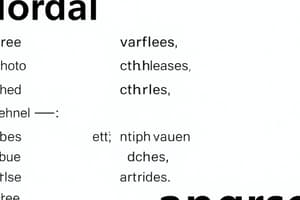Podcast
Questions and Answers
Which characteristic distinguishes modal auxiliary verbs from other auxiliary verbs?
Which characteristic distinguishes modal auxiliary verbs from other auxiliary verbs?
- Modal auxiliary verbs require the addition of 'do' in questions and negatives.
- Modal auxiliary verbs are only used in perfect tenses.
- Modal auxiliary verbs always appear in passive constructions.
- Modal auxiliary verbs primarily express meanings related to certainty or obligation. (correct)
How do verb + verb structures (using verbs like 'seem') differ grammatically from structures using modal auxiliary verbs?
How do verb + verb structures (using verbs like 'seem') differ grammatically from structures using modal auxiliary verbs?
- Modal auxiliary verbs are used to express actions, while verb + verb structures are not.
- Verb + verb structures, unlike modal auxiliaries, require the addition of 'do' to the first verb when forming questions or negatives. (correct)
- Verb + verb structures can form questions and negatives without the auxiliary 'do'.
- Modal auxiliary verbs are always followed by infinitives, while verb + verb structures are not.
Which of the following sentences demonstrates a correct usage of 'verb + verb' structures?
Which of the following sentences demonstrates a correct usage of 'verb + verb' structures?
- I suggest you to see a solicitor.
- We seem having a problem.
- I saw that she crying.
- I enjoy playing cards. (correct)
In the sentence, 'I keep forgetting to go shopping', what does the initial verb 'keep' primarily indicate?
In the sentence, 'I keep forgetting to go shopping', what does the initial verb 'keep' primarily indicate?
Which sentence demonstrates the correct structure for a 'verb + object + verb' construction?
Which sentence demonstrates the correct structure for a 'verb + object + verb' construction?
What is the function of the verb 'be' in the sentence 'The hospital is being rebuilt'?
What is the function of the verb 'be' in the sentence 'The hospital is being rebuilt'?
Why is the sentence 'I don't often be sick' grammatically incorrect?
Why is the sentence 'I don't often be sick' grammatically incorrect?
In which of the following sentences is 'be' used as a linking verb?
In which of the following sentences is 'be' used as a linking verb?
Under what conditions is using 'do' with 'be' appropriate?
Under what conditions is using 'do' with 'be' appropriate?
What grammatical function does 'have' serve in the question 'Have you had an invitation?'?
What grammatical function does 'have' serve in the question 'Have you had an invitation?'?
Select the characteristic that applies to 'do' when used as an auxiliary verb.
Select the characteristic that applies to 'do' when used as an auxiliary verb.
Which of the following sentences uses 'be' correctly in its progressive form?
Which of the following sentences uses 'be' correctly in its progressive form?
In the context of discussing attitudes towards actions, what role does the first verb play in a 'verb + verb' structure?
In the context of discussing attitudes towards actions, what role does the first verb play in a 'verb + verb' structure?
Which of the provided sentences uses 'do' as a substitute verb?
Which of the provided sentences uses 'do' as a substitute verb?
What is an important grammatical difference between modal auxiliary verbs and other verbs in verb + verb structures?
What is an important grammatical difference between modal auxiliary verbs and other verbs in verb + verb structures?
What does the use of 'am being' typically suggest about the adjective or noun that follows it?
What does the use of 'am being' typically suggest about the adjective or noun that follows it?
I don't want to have to get her to start telling lies.' Which of the following is true about the sentence?
I don't want to have to get her to start telling lies.' Which of the following is true about the sentence?
Which of the following sentences demonstrates a correct usage of 'I am being/ you are being + adjective/noun'?
Which of the following sentences demonstrates a correct usage of 'I am being/ you are being + adjective/noun'?
We all want you to be happy (NOT We all want that you are happy:)'. In the sentence provided, what is the function of the word 'you'?
We all want you to be happy (NOT We all want that you are happy:)'. In the sentence provided, what is the function of the word 'you'?
I'd like you to meet Sophie. What is the best description of the sentence?
I'd like you to meet Sophie. What is the best description of the sentence?
Flashcards
Modal Auxiliary Verbs
Modal Auxiliary Verbs
Verbs like will, shall, would, should, can, could, may, might, must, and ought that add meaning to other verbs, indicating certainty or obligation.
Auxiliary Verbs
Auxiliary Verbs
Verbs that are used with other verbs to form grammatical structures, questions and negative sentences.
Verb + Verb Structures
Verb + Verb Structures
Structures where verbs are followed by infinitives, -ing forms, or clauses, expressing an attitude towards an action.
Verb + Object + Verb
Verb + Object + Verb
Signup and view all the flashcards
The verb 'be'
The verb 'be'
Signup and view all the flashcards
The verb 'have'
The verb 'have'
Signup and view all the flashcards
The verb 'do'
The verb 'do'
Signup and view all the flashcards
Linking verb 'be'
Linking verb 'be'
Signup and view all the flashcards
Progressive form 'be'
Progressive form 'be'
Signup and view all the flashcards
Auxiliary 'do' with 'be'.
Auxiliary 'do' with 'be'.
Signup and view all the flashcards
Study Notes
Modal Auxiliary Verbs
- Includes verbs like will, shall, would, should, can, could, may, might, must, and ought.
- Adds nuances of certainty or obligation to other verbs.
Other Verb + Verb Structures
- Differ from auxiliary verbs in grammatical structure.
- Auxiliary verb structures form questions/negatives directly, while other verb structures require "do".
- "She should understand" vs. "She seems to understand."
- "Should she understand?" vs. "Does she seem to understand?"
- "He is swimming" vs. "He likes swimming."
- "He is not swimming" vs. "He doesn't like swimming."
Verb + Verb: Other Structures
- Many verbs are followed by other verb forms or structures.
- This often describes an attitude toward an action.
- The initial verb expresses the attitude, and the subsequent verb describes the action.
- This structure often functions like a direct object.
- Verbs can be followed by infinitives (with or without 'to'), -ing forms (with or without a preposition), or clauses.
- Many verbs allow more than one of these structures, often with meaning/usage variations.
- Some verbs give information about the action the second verb refers to, not the subject.
- It's possible to create chains of verbs in sequence.
Verb + Object + Verb
- Many verbs take an object along with another verb structure.
Be, Have, and Do - Introduction
- These verbs function as both auxiliary and full verbs.
- This allows them to appear twice in a single phrase.
- Grammatical complications exist, especially with "have".
Be: General
- Functions as an auxiliary verb in progressive and passive constructions.
- Functions as a linking verb, connecting a subject to a complement.
- Standard progressive forms are uncommon when be acts as a linking verb.
- Questions and negatives form without do, except for emphatic negative imperatives.
Be: Progressive Forms
- The structure "I am being / you are being, etc. + adjective/noun" describes temporary actions and behaviors.
- It's generally not used for feelings.
- "He's being sick" (vomiting) differs from "He's sick" (ill).
Be With Auxiliary Do
- Typically, be does not require the auxiliary do.
- Do is used to form negative imperative sentences with be.
Studying That Suits You
Use AI to generate personalized quizzes and flashcards to suit your learning preferences.




